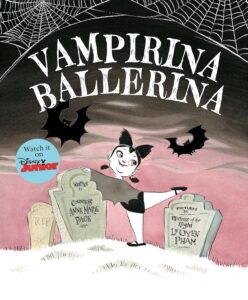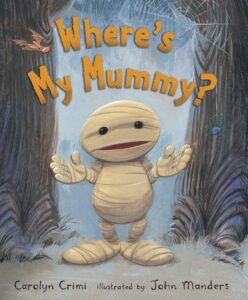 This month, we’re delighted to welcome Ame Dyckman to our Author Interview series! Ame is a New York Times bestselling, award-winning author renowned for her humorous and heartwarming picture books. She burst onto the scene with her debut Boy + Bot (2012), a charming tale of friendship between a boy and a robot. She continued to captivate young readers with Tea Party Rules (2013), Wolfie the Bunny (2015), and Horrible Bear! (2016). Ame’s witty storytelling shines in You Don’t Want a Unicorn! (2017) and its sequel You Don’t Want a Dragon! (2020). Her recent works include Dandy (2019), That’s Life! (2020), How Dinosaurs Went Extinct: A Safety Guide (2023), Don’t Blow Your Top! (2023), Campingland (2024), Silly Boobies: A Love Story (2024), and others.
This month, we’re delighted to welcome Ame Dyckman to our Author Interview series! Ame is a New York Times bestselling, award-winning author renowned for her humorous and heartwarming picture books. She burst onto the scene with her debut Boy + Bot (2012), a charming tale of friendship between a boy and a robot. She continued to captivate young readers with Tea Party Rules (2013), Wolfie the Bunny (2015), and Horrible Bear! (2016). Ame’s witty storytelling shines in You Don’t Want a Unicorn! (2017) and its sequel You Don’t Want a Dragon! (2020). Her recent works include Dandy (2019), That’s Life! (2020), How Dinosaurs Went Extinct: A Safety Guide (2023), Don’t Blow Your Top! (2023), Campingland (2024), Silly Boobies: A Love Story (2024), and others.
Residing in New Jersey with her family and a yard full of wild critters that often inspire her stories, Ame is known for her energetic and goofy personality. We’re excited to chat with her about her writing journey, the picture book industry, and the creative process behind her enchanting stories.
RVC: You’ve got a name that is potentially mis-pronounceable. Help us out, please! (This is coming from “Ryan Cleave,” “G. Van,” Van Cleave,” “Dr. GCleaveRyan,” and a host of other almost-there-but-not-quite ones!)
AD: Hi, Ryan! Thanks for the terrific intro, and thanks for having me! “Ame” is pronounced just like “Amy,” but it’s spelled differently ’cause… I’m actually an Amelia—like the Amelia Bedelia books! And “Dyckman” rhymes with “Bikeman.” (My Husband Guy’s ancestors were Dutch. Dunno if they sold bikes, but it they did, I hope one was known as Dyckman the Bikeman! Ha!)
RVC: Hah indeed–thanks for the clarifications. Now, please share how you first became interested in writing children’s picture books.
AD: As a kid, I thought about becoming a writer, but grown-ups said, “You’ll starve!” Starving sounded uncomfortable, so I pursued other employment. But when I worked as teacher, and after my own kiddo was born, I realized reading picture books together is the best thing ever, and I wanted to be a picture book author! But I didn’t know how. So I asked my smartest friend, “How do I learn to write for kids and get published?” And Google said: “Join SCBWI!” (Society of Book Writers and Illustrators.) I did. And it worked!
RVC: SCBWI is the path taken by so, so many authors I interview here. I’m glad it worked for you, too. Tell us the story behind your first published picture book.
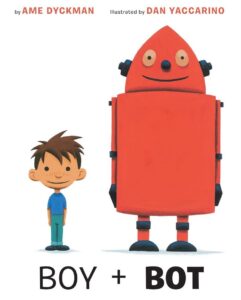 AD: I’ve always loved friendship-despite-difference stories—and robots. So I squished these two loves together in my first book, Boy + Bot. I pitched it to Super Agent Scott Treimel at a “Pitch The Agent” session at a SCBWI conference, and that was the start of everything! Together, we’ve sold 36 kidlit titles—and counting!
AD: I’ve always loved friendship-despite-difference stories—and robots. So I squished these two loves together in my first book, Boy + Bot. I pitched it to Super Agent Scott Treimel at a “Pitch The Agent” session at a SCBWI conference, and that was the start of everything! Together, we’ve sold 36 kidlit titles—and counting!
RVC: What’s the best lesson that book taught you?
AD: Boy + Bot taught me a lot about Big Picture Messages in books. When I wrote it, I wasn’t consciously thinking about Big Picture Messages—I thought I was just writing a friendship story! But once it was published, I heard from lots of folks who enjoyed my book in part ’cause they saw different Big Picture Messages and topics in it: inclusivity, kindness, caretaking, STEM, etc. It made me realize first-hand how multi-layered picture books can be, and now I absolutely consider Big Picture Messages when I write!
RVC: Some readers and writers don’t realize that the final picture book text is often missing things that were there earlier in the process. What’s something fun that didn’t make the final cut with this book?
AD: Word about words! There’s often lots of text that gets cut during Revisions, and again when you get sketches and the art shows what you no longer need to tell. Boy + Bot was a really tight text from the start—just 150ish words or so—but with other books I’ve cut multiple pages, “killed” characters entirely (sorry, darlings!), and dramatically shortened narratives and dialogue. I actually love Revisions, especially after sketches, ’cause that’s when things get really collaborative with the editor, illustrator, art director and/or designer, and copywriter. When everyone’s brainstorming together to make the very best book we can? Nothing beats that!
RVC: Please walk us through your writing process. How do you go from an initial idea to a finished manuscript?
AD: Coffee! And I’m constantly jotting down ideas for stories—on my phone, napkins… even my arm! (“Oh, no! I just washed my plot!”)
RVC: HAH!
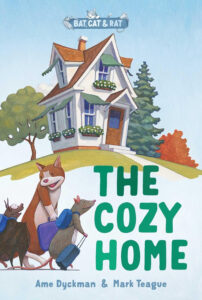 AD: And then I wait for characters to speak to me. Sometimes this happens immediately, but sometimes it takes years before I feel who a character is, how they sound, and what they say and do. (One of my latest projects, the Bat, Cat & Rat series with the legendary Mark Teague, took over a decade before the first book, The Cozy Home, was published!) After all this simmering, once characters “click,” I’m itching to write their story! Things usually move pretty quickly from there. For picture books, lately this means two weeks of drafting and reading dialogue aloud. (Walk by my house and you will hear voices! Ha!) Then I’ll carry the printed story around for another week or two, scribbling on it and making small tweaks, followed by a few days of “Am I ready to send?!” before I actually hit Send. Then my agent and I chat about it and who we want to send it to, I make more coffee… and repeat!
AD: And then I wait for characters to speak to me. Sometimes this happens immediately, but sometimes it takes years before I feel who a character is, how they sound, and what they say and do. (One of my latest projects, the Bat, Cat & Rat series with the legendary Mark Teague, took over a decade before the first book, The Cozy Home, was published!) After all this simmering, once characters “click,” I’m itching to write their story! Things usually move pretty quickly from there. For picture books, lately this means two weeks of drafting and reading dialogue aloud. (Walk by my house and you will hear voices! Ha!) Then I’ll carry the printed story around for another week or two, scribbling on it and making small tweaks, followed by a few days of “Am I ready to send?!” before I actually hit Send. Then my agent and I chat about it and who we want to send it to, I make more coffee… and repeat!
RVC: How does your everyday life and the “wacky wild critters” in your yard inspire your stories?
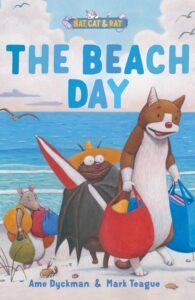 AD: Little bits of my Real Life definitely show up in my writing! (Like in the upcoming Bat, Cat & Rat #3: The Beach Day, when Bat tries to share his snack with hungry gulls—and it goes terribly wrong! This actually happened to me!) Almost all my book characters are autobiographical or based on someone in my family—or our “tenants.” We’ve had bunnies, deer, groundhogs, squirrels, birds, skunks, etc. make themselves a little-too-comfortable in our yard and shed, and on our deck and porch. (And that “etc.” includes a fox who’d come running every time we ordered rotisserie chicken! We had to tip our driver extra!) But watching lots of different animals—at a park, a zoo, or right at home—and imagining what they’d talk about is one of the best ways to practice writing funny picture book dialogue, and what I “hear” these furred-or-feathered goofballs say often shows up in my books.
AD: Little bits of my Real Life definitely show up in my writing! (Like in the upcoming Bat, Cat & Rat #3: The Beach Day, when Bat tries to share his snack with hungry gulls—and it goes terribly wrong! This actually happened to me!) Almost all my book characters are autobiographical or based on someone in my family—or our “tenants.” We’ve had bunnies, deer, groundhogs, squirrels, birds, skunks, etc. make themselves a little-too-comfortable in our yard and shed, and on our deck and porch. (And that “etc.” includes a fox who’d come running every time we ordered rotisserie chicken! We had to tip our driver extra!) But watching lots of different animals—at a park, a zoo, or right at home—and imagining what they’d talk about is one of the best ways to practice writing funny picture book dialogue, and what I “hear” these furred-or-feathered goofballs say often shows up in my books.
RVC: How has your writing process evolved since your first books were published?
 AD: Starting with You Don’t Want a Unicorn! (with the phenomenal Liz Climo), I started mapping out the layouts for my books—page turns, etc.—right at my first draft stage. Of course these layouts aren’t written in stone, and we often make layout changes along the way, but thinking about what could go on each picture book page from the very start has, I think, made “awww” moments resonate better and jokes “hit” funnier!
AD: Starting with You Don’t Want a Unicorn! (with the phenomenal Liz Climo), I started mapping out the layouts for my books—page turns, etc.—right at my first draft stage. Of course these layouts aren’t written in stone, and we often make layout changes along the way, but thinking about what could go on each picture book page from the very start has, I think, made “awww” moments resonate better and jokes “hit” funnier!
RVC: Your books are known for their humor and goofiness. How do you tap into that playful side when writing for children?
AD: Kids are humorous and goofy—and there’s no such thing as “too silly!” to a kid. So when I write for kids, I try to remember that. (And then I get to be a kid again, too!)
RVC: Here’s a critter story (which I hope isn’t from your backyard!). Misunderstood Shark flips the script on the typical shark stereotype. What’s the funniest misconception about sharks you’ve come across, and how did you incorporate humor into debunking these myths in your book?
 AD: Making the Misunderstood Shark books (Misunderstood Shark and our “sequel,” Misunderstood Shark: Friends Don’t Eat Friends) with the spectacular Scott Magoon was a riot! We loved showing that sharks really aren’t interested in eating people. (Like when our Shark smells a drop of blood in the water, races towards the beachgoers, bursts out of the water—and offers “boo-boo strips!” instead.) And my favorite “Fun Fact” we included is that a person is thousands of times more likely to be bitten by another person than bitten by a shark! (You should’ve seen all the little hands shoot up in the air at school visits when I asked who’d ever been bitten by a classmate! Ha!)
AD: Making the Misunderstood Shark books (Misunderstood Shark and our “sequel,” Misunderstood Shark: Friends Don’t Eat Friends) with the spectacular Scott Magoon was a riot! We loved showing that sharks really aren’t interested in eating people. (Like when our Shark smells a drop of blood in the water, races towards the beachgoers, bursts out of the water—and offers “boo-boo strips!” instead.) And my favorite “Fun Fact” we included is that a person is thousands of times more likely to be bitten by another person than bitten by a shark! (You should’ve seen all the little hands shoot up in the air at school visits when I asked who’d ever been bitten by a classmate! Ha!)
RVC: Let’s take a recent case study, like Silly Boobies: A Love Story. Give me the story pitch please!
 AD: Silly Boobies: A Love Story is The Sneetches meets Romeo and Juliet meets modern politics meets Mutual of Omaha’s Wild Kingdom!
AD: Silly Boobies: A Love Story is The Sneetches meets Romeo and Juliet meets modern politics meets Mutual of Omaha’s Wild Kingdom!
RVC: Wow, what a logline. Love it.
AD: In Silly Boobies (brilliantly-illustrated by the brilliant illustrator/political cartoonist Christopher Weyant), red-footed boobies and blue-footed boobies are pretty similar—but they each think they’re the superior boobies! Until a young female red-footed booby and a young male blue-footed booby (the book readers in their groups, naturally) meet and fall in love. Their families don’t approve, but they get married anyway—and then, something truly beautiful happens!
RVC: I’ve read the (many) reviews, so I know what readers like. But what do YOU like most about this book?
AD: I love that Silly Boobies: A Love Story shows that even set-in-their-ways people can change and embrace difference, and I love that we got to include real facts about all the real kinds of boobies in the back of our book. (Like that the collective noun for a group of boobies is “a Congress!” I was rolling on the floor when I learned that one! Ha!)
RVC: You’ve mentioned that you prefer writing over creating a fancy website. How important is it for authors to focus on their craft versus self-promotion?
AD: It’s so easy to get stuck on the self-promo treadmill—it can become a career in itself! (At various times I was doing a blog, too much social media, every print and online interview that asked, bookstore visits, book festivals, virtual school-visits, in-person school visits, SCBWI volunteering and presenting at conferences and events, and producing/printing/packaging/shipping many, many tens-of-thousands of “swag” items: bookmarks, stickers, buttons, bracelets, squishies, mini Frisbees, etc.! Whew!) But when the world paused during the Pandemic, I paused, too! I looked at all my book ideas and works-in-progress and realized if I couldn’t successfully clone myself—which hadn’t gone well—that I’d better write more and self-promote less. Now I just do the promo opportunities I really want to do—like this one! And since adopting my write more/promote less philosophy, the number of new books I’ve written/we’ve sold has skyrocketed! (And if you see a vaguely-Ame-shaped creature roaming New Jersey… that’s just your imagination!)
RVC: I’ll have to keep an eye out for that vaguely-Ame-shaped creature! Now, how has social media influenced your interaction with readers and the promotion of your books?
AD: I’ve “met” and even met so many super-nice readers thanks to social media! And social media is excellent for sharing new book news, doing giveaways, and just letting folks get to know the person behind the books. My favorite thing when I meet someone in Real Life that I know from social media is when they say, “You talk just like you post, and you post just like you talk!” Ha!
RVC: Does your often-funny social media voice influence your funny kidlit writing? How so?
 AD: Thank you! And… sometimes! Sometimes I’ll post an idea or a little poem. Sometimes these will go on to become a story idea, or illustrators will illustrate these posts just for fun. (I love when this happens!) And sometimes-sometimes, I get to then actually work with one of my illustrator-pals-I-met-via-social-media on actual books! (Like the fantastic Charles Santoso of Dandy and the fantastic James Burks of Campingland and the fantastic Elio of the Monster Og series!) Publishing works in mysterious ways!
AD: Thank you! And… sometimes! Sometimes I’ll post an idea or a little poem. Sometimes these will go on to become a story idea, or illustrators will illustrate these posts just for fun. (I love when this happens!) And sometimes-sometimes, I get to then actually work with one of my illustrator-pals-I-met-via-social-media on actual books! (Like the fantastic Charles Santoso of Dandy and the fantastic James Burks of Campingland and the fantastic Elio of the Monster Og series!) Publishing works in mysterious ways!
RVC: With so many books published and more on the way, how do you stay inspired and avoid burnout?
AD: I read! Reading what other folks have created is the Ultimate Collective Brain Hug and boost!
RVC: One last question for this part of the interview. What’s next for you? Can you share any upcoming projects or books you’re especially excited about?
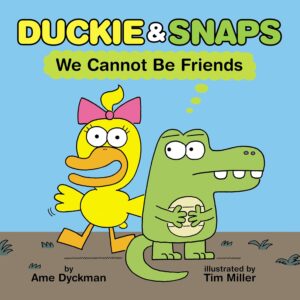 AD: For 2025, Duckie & Snaps #1: We Cannot Be Friends with the genius Tim Miller pubs in February. Bat, Cat & Rat #3: The Beach Day pubs in April. Bat, Cat & Rat #4: A Great Fall pubs in July. In 2026, there’s Duckie & Snaps #2: We Cannot Be Brave in the Spring, and the rest of the year will see two more Monster Og Ready-To-Read titles, two more Bat, Cat & Rat books, and I believe a total of three stand-alone picture books so far, including the just-announced To The Actual Moon And Back with the dynamic duo of Dan & Jason in the Fall! We’re gonna need a bigger coffee!
AD: For 2025, Duckie & Snaps #1: We Cannot Be Friends with the genius Tim Miller pubs in February. Bat, Cat & Rat #3: The Beach Day pubs in April. Bat, Cat & Rat #4: A Great Fall pubs in July. In 2026, there’s Duckie & Snaps #2: We Cannot Be Brave in the Spring, and the rest of the year will see two more Monster Og Ready-To-Read titles, two more Bat, Cat & Rat books, and I believe a total of three stand-alone picture books so far, including the just-announced To The Actual Moon And Back with the dynamic duo of Dan & Jason in the Fall! We’re gonna need a bigger coffee!
RVC: Okay, Ame…now it’s time for you to bring out your speedy wit. It’s the ZIPPY SKIPPY SUPER ZOOM SPEED ROUND! Quick-ish questions and blazingly brisk answers please. Are you ready?
AD: Ready!
RVC: If you could have any superpower, what would it be?
AD: Multiplication! (Of me, I mean. Not like, 9 x 13. Which is…) Okay, next question!
RVC: What’s your go-to karaōke song?
AD: “Little Room” by The White Stripes.
RVC: Favorite pun or dad joke?
AD: What kind of cheese isn’t yours? Nacho cheese!
RVC: If you want to LOL with a picture book, name a book you’re likely to pull from your shelves.
 AD: I’d Really Like To Eat A Child by Sylviane Donnio, illustrated by Dorothée de Monfreid. (Kids who see you reading it run away so fast!)
AD: I’d Really Like To Eat A Child by Sylviane Donnio, illustrated by Dorothée de Monfreid. (Kids who see you reading it run away so fast!)
RVC: If you could give your younger self one piece of picture-book advice, what would it be?
AD: Create more, promote (and worry) less!
RVC: What are you most grateful for in your career?
AD: Coffee—I mean, my family, agent, editors, and readers! Truly.
RVC: Thanks so much, Ame!
AD: Thanks again for having me, Ryan! This was fun!


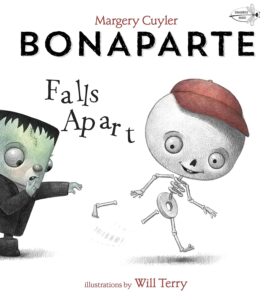
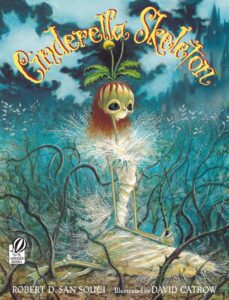 Cinderella Skeleton
Cinderella Skeleton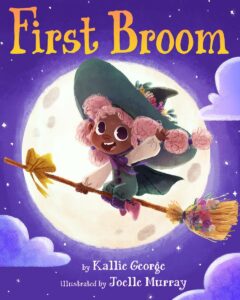 First Broom
First Broom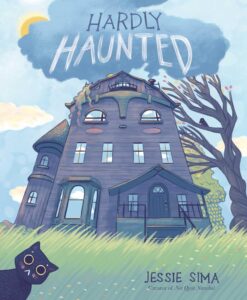 Hardly Haunted
Hardly Haunted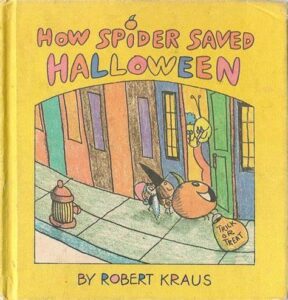 How Spider Saved Halloween
How Spider Saved Halloween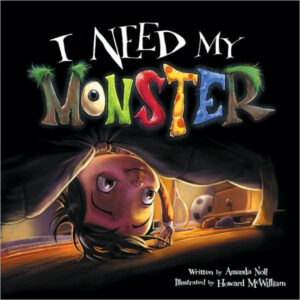
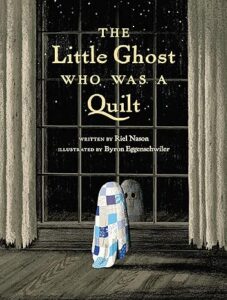
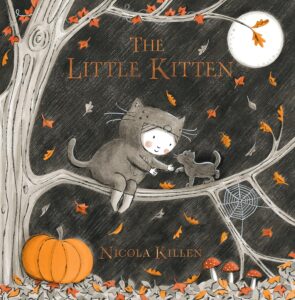 The Little Kitten
The Little Kitten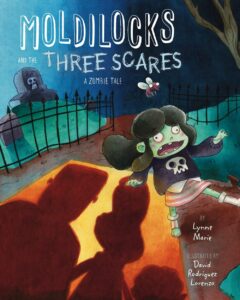 Moldilocks and the Three Scares: A Zombie Tale
Moldilocks and the Three Scares: A Zombie Tale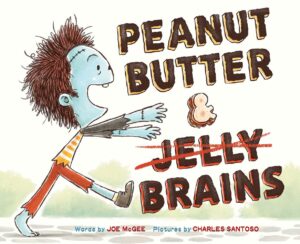 Peanut Butter
Peanut Butter 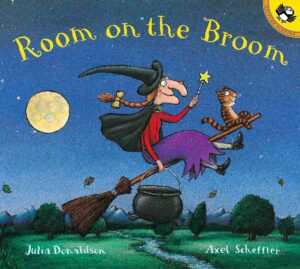 Room on the Broom
Room on the Broom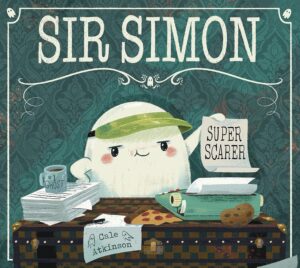 Sir Simon: Super Scarer
Sir Simon: Super Scarer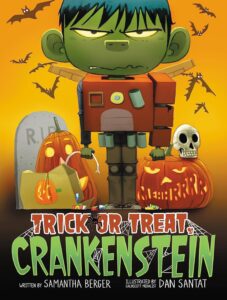 Trick or Treat, Crankenstein
Trick or Treat, Crankenstein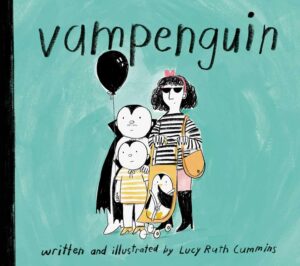 Vampenguin
Vampenguin